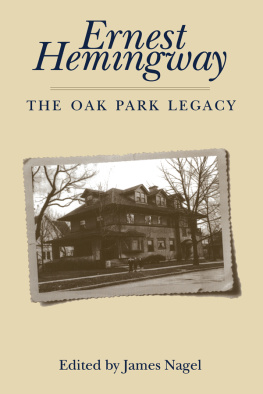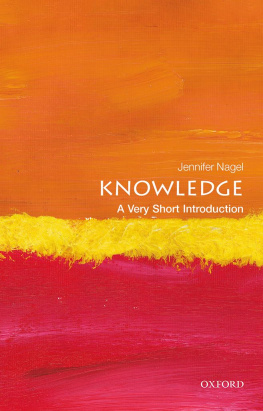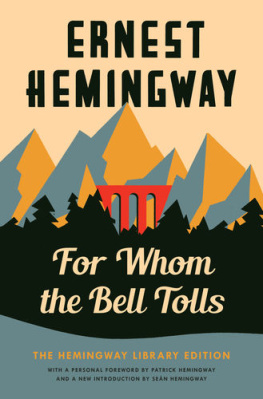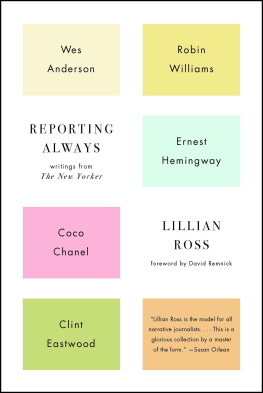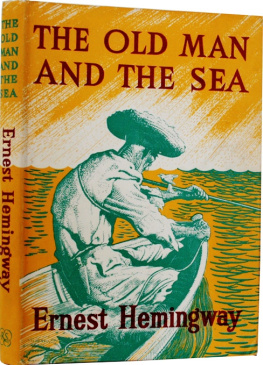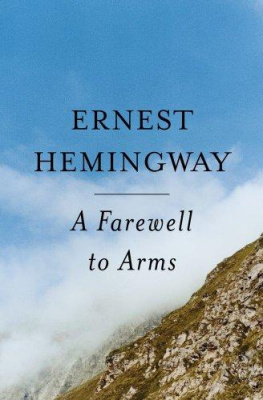Nagel - Ernest Hemingway
Here you can read online Nagel - Ernest Hemingway full text of the book (entire story) in english for free. Download pdf and epub, get meaning, cover and reviews about this ebook. publisher: University of Alabama Press, genre: Non-fiction. Description of the work, (preface) as well as reviews are available. Best literature library LitArk.com created for fans of good reading and offers a wide selection of genres:
Romance novel
Science fiction
Adventure
Detective
Science
History
Home and family
Prose
Art
Politics
Computer
Non-fiction
Religion
Business
Children
Humor
Choose a favorite category and find really read worthwhile books. Enjoy immersion in the world of imagination, feel the emotions of the characters or learn something new for yourself, make an fascinating discovery.
- Book:Ernest Hemingway
- Author:
- Publisher:University of Alabama Press
- Genre:
- Rating:3 / 5
- Favourites:Add to favourites
- Your mark:
- 60
- 1
- 2
- 3
- 4
- 5
Ernest Hemingway: summary, description and annotation
We offer to read an annotation, description, summary or preface (depends on what the author of the book "Ernest Hemingway" wrote himself). If you haven't found the necessary information about the book — write in the comments, we will try to find it.
Nagel: author's other books
Who wrote Ernest Hemingway? Find out the surname, the name of the author of the book and a list of all author's works by series.
Ernest Hemingway — read online for free the complete book (whole text) full work
Below is the text of the book, divided by pages. System saving the place of the last page read, allows you to conveniently read the book "Ernest Hemingway" online for free, without having to search again every time where you left off. Put a bookmark, and you can go to the page where you finished reading at any time.
Font size:
Interval:
Bookmark:

THE OAK PARK LEGACY
Copyright 1996
The University of Alabama Press
Tuscaloosa, Alabama 35487-0380
All rights reserved
Manufactured in the United States of America
The paper on which this book is printed meets the minimum requirements of American National Standard for Information Science-Permanence of Paper for Printed Library Materials, ANSI Z39.48-1984.
Library of Congress Cataloging-in-Publication Data
Ernest Hemingway : the Oak Park legacy / edited by James Nagel.
p. cm.
Essays presented at a conference held July 1721, 1993, in Oak Park, Ill.
Includes bibliographical references (p. ) and index.
ISBN 0817308423
1. Hemingway, Ernest, 18991961Criticism and interpretationCongresses. 2. Hemingway, Ernest, 18991961Childhood and youthCongresses. 3. Authors, American20th centuryBiographyCongresses. 4. Oak Park (Ill.)BiographyCongresses. I. Nagel, James.
PS3515.E37Z58688 1996
813.52dc20
965033
CIP
British Library Cataloguing-in-Publication Data available
ISBN-13 978-0-8173-9131-7 (electronic)
In memory of
JOHN OLIN EIDSON
JAMES NAGEL
The essays in this collection, all of them published here for the first time, were presented as part of Ernest Hemingway: The Oak Park Legacy, a conference held in Hemingways hometown, July 1721, 1993, under the sponsorship of The Ernest Hemingway Foundation of Oak Park. Although this volume contains a selection of the papers presented at the program, it cannot attempt to capture the energy and excitement that characterized the entire event, with the presentation of a new play (Lovely Walloona, written by Morris Buske) and tours of the Hemingway house, the Oak Park and River Forest High School, and the many Frank Lloyd Wright homes in the community. It was an exciting and informative three days for the hundreds of participants who attended the conference, a joyful tribute to the young man who grew up in this village to become a Nobel laureate for literature.
In addition to the scholars whose essays are here collected, many other people participated in the program and contributed to the informed discussion that enlivened the conference. One of the most intriguing events was a panel discussion devoted to Hemingway in International Perspective, with Judy Hen (Israel), Xiaoming Huang (Peoples Republic of China), Carlos Azevedo (Portugal), Kazuhira Maeda (Japan), and Ove G. Swensson (Sweden) as participants. In more formal investigations of Hemingways works, Joseph Waldmeier, John P. Weber, RobertMartin, James Steinke, Robert W. Trogdon, Linda Wagner-Martin, Carolyn Poplett, Redd Griffin, Michael Seefeldt, Janice R. Byrne, and Rose Marie Burwell made important contributions in forms that could not be represented here. Scott Schwar, President of The Ernest Hemingway Foundation of Oak Park, supervised local arrangements along with Jeanette Fields, Redd Griffin, and especially Barbara Ballinger, the archivist for the Hemingway Museum. Stephen Plotkin, of the Hemingway Collection at the John F. Kennedy Presidential Library in Boston, discussed the materials in that archive, including the scrapbooks that Grace kept throughout Ernest Hemingways childhood, and Barbara Ballinger described the extensive collection of family papers donated to the Oak Park museum by Marcelline Hemingway Sanford, Ernest Hemingways older sister. Marcellines two sons, John and James Sanford, shared memories of their celebrated uncle. Waring Jones spoke about an important collection of Hemingway manuscripts and letters he donated to the museum, documents now permanently available for scholarly investigation.
In a larger sense, the entire community of Oak Park participated in the celebration with a picnic in the town park and the dedication of the Hemingway birthplace at 339 North Oak Park Avenue as an educational museum. The preservation and restoration of the authors home was a suitable conclusion to the conference and the beginning of a new series of literary events for those interested in the life and works of Ernest Hemingway. In a small gesture of support from the scholars whose essays are here published, the proceeds of this volume will be dedicated to the support of this facility.
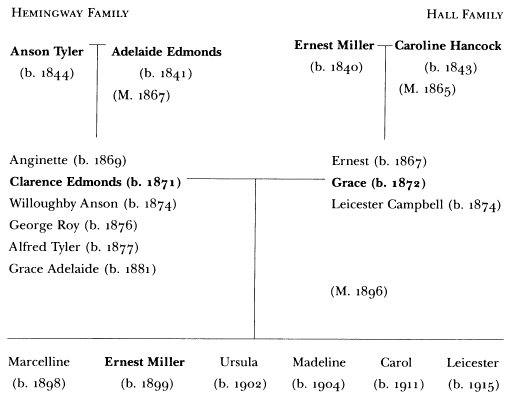
JAMES NAGEL
YOUNG WILLYS WAS SICK when Harriet Hemingway opened her new diary on January 1, 1852, and the next day Dr. Woodruff came to the house and administered leeches. Testifying to the efficacy of the treatment, the boy quickly recovered. The Hemingways were living in Plymouth, Connecticut, that year, and they had a complex family. Harriet was not Allen Hemingways first wife; he had married her aunt Marietta in 1833, and that union had produced five children: Rodney (b. 1835); Riley (b. 1836), who died at the age of three, the first of many tragedies in a family with more than its fair share; Mary Ann (b. 1837); Rocelina (b. 1839); and George (b. 1842), the same year his mother died. Six months later Allen married Harriet, the daughter of Anson and Harriet Tyler. So when her own son (the paternal grandfather of Ernest Hemingway) was born on August 26, 1844, she named him Anson, after her father. Willys followed in 1847, and a daughter, Harriet Lucretia, in 1850. The Hemingways were never very inventive about names, using the same ones, or variations, generation after generation.
With seven children living in the household, and with Allen established as the postmaster for nearby Terryville in addition to running the general store, the family would seem to have been firmly settled. From the indications in Harriets diary, they knew everyone for miles around, they were surrounded by relatives, Church on account of misconduct with Mr. Atwaters daughter.
But most of her diary covers the mundane responsibilities of running a large household, with a special stress on travel to neighboring communities (particularly Hartford), her deep love for her husband and children, financial transactions, and her tendency to see her life in historical perspective, observing the anniversaries of significant family events well in the past. She seems to have deeply enjoyed a trip to Boston in September 1852, staying at the Pearl Street Hotel and touring the Museum of Fine Art, and it is clear that it was a buying trip for Allen, restocking the store. She ended her diary for that year on a typically reflective note: And now the year is about to close and what great reason have we to be thankful that our family have enjoyed very good health the most of the year and that we are all permitted to see the close of this day as well as year. Lord help us all to live as we shall wish we had done when we come to die.
The following year passed in Harriets diary without major incident, although in October 1853 Harriet bore her last child, Adelbert Porter Hemingway, called Delly within the family.
But 1854 brought an end to this phase of the life of the Hemingway family, for Allen, for the first time, announced his intention to move the family to Illinois: Mr. Hemingway is quite engaged about going out West to buy a farm for his boys, she wrote on January 18. The motivation for the move seems clearly to have been the need for employment for his sons, for Rodney was already nineteen, George was twelve, and there were three younger boys. Land was expensive in Connecticut, the fields were flinty, the weather uncertain. Opportunity lay in the Midwest, with its level expanse of rich soil. A man with a steady job in Chicago could do worse than to purchase a farm for his boys. Harriets hesitation about the idea seems to have more to do with her need for her husbands constant companionship than for her devotion to Connecticut, as when she recorded that Mr. Hemingway is talking some of going to Illinois in the course of a few weeks. I can hardly consent to have him go (January 26, 1854).
Font size:
Interval:
Bookmark:
Similar books «Ernest Hemingway»
Look at similar books to Ernest Hemingway. We have selected literature similar in name and meaning in the hope of providing readers with more options to find new, interesting, not yet read works.
Discussion, reviews of the book Ernest Hemingway and just readers' own opinions. Leave your comments, write what you think about the work, its meaning or the main characters. Specify what exactly you liked and what you didn't like, and why you think so.

